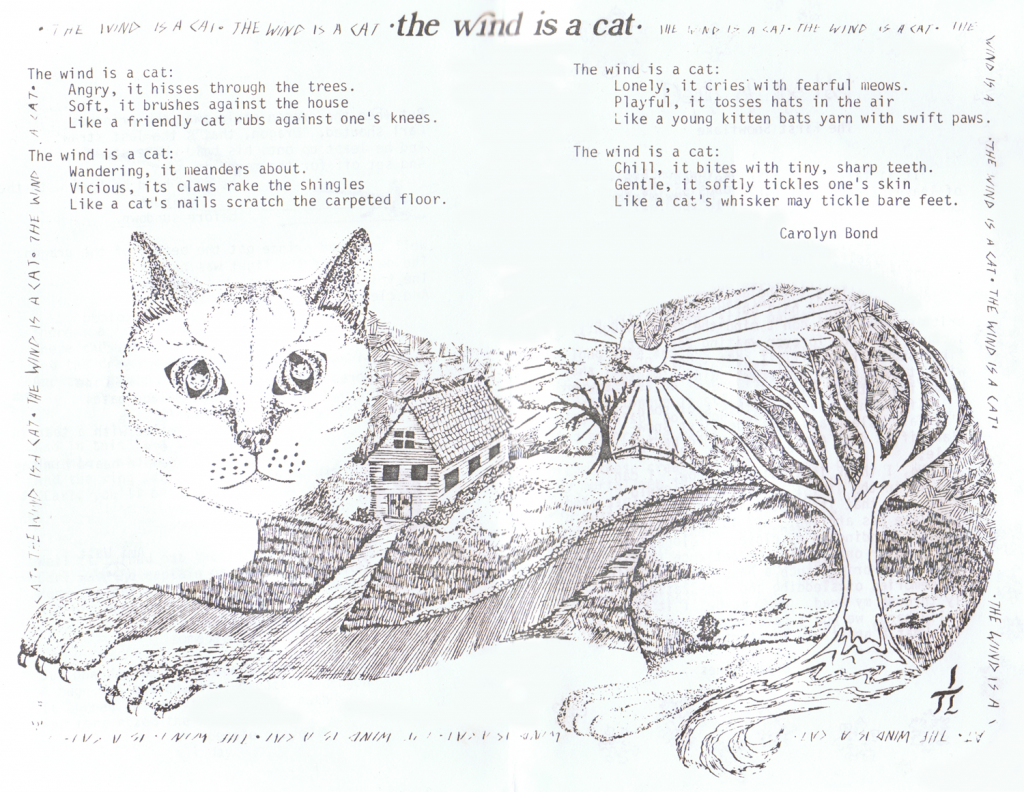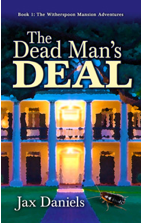The wind is a cat:
Angry, it hisses through the trees.
Soft, it brushes against the house
Like a friendly cat rubs against one’s knees.
The wind is a cat:
Wandering, it meanders about
Vicious, its claws rake the shingles
Like a cat’s nails scratch the carpeted floor.
The wind is a cat:
Chill, it bites with tiny, sharp teeth
Gentle, it softly tickles one’s skin
Like a cat’s whiskers may tickle bare feet.
~Carolyn Bond
I liked this poem when I read it in eleventh grade. It fired up my imagination, so since I was on the high school lit magazine, I volunteered to do the artwork for it. Back then, as now, I had the perfect personality for editing and line art: I was an uptight perfectionist.
Deadlines were approaching so I stayed after school. I was working in the art room with a true artist, which even then I knew I was not. I was an illustrator, but James, he was the real thing. As I drew my stylized picture of a cat, I screwed up…something I did a lot with my illustration. After muttering a few mild curses, I was only sixteen after all, I asked James to pass me the whiteout. This was for repro on a Xerox machine. The whiteout wouldn’t register. James picked up the little bottle, but instead of handing it to me, he put it in his pocket.
“But I made a mistake, I need it!” I protested.
“No, you don’t,” he told me. “It’s not a mistake, it’s an opportunity. Embrace it. Turn it into part of your picture.”
I was not at all happy about that, but the deadline was looming. I altered my plan and did just what he said; I incorporated it into the drawing. I did it well enough, that I cannot tell you today where that mistake was. It is no longer a mistake, it is art.
It was a lesson I picked up readily for my artwork and used as I minored in art in college. But I wasn’t clever enough to apply it more broadly to my other art—writing. Not until I met Teresa Edgerton.
We used to take long walks and talk about the craft of writing. At one point, I became stuck in my writing. I could not find may way out of the labyrinth of plot I’d constructed for my characters. She told me something similar to what James had told me: Look back at your work. What is there that you can use for your needs now? As with James, I had my doubts, but I also had nothing to lose. So I combed over my story and found just what she had said I would. The seeds of something I’d not even known I’d planted were now grown enough for me to use to climb out of my maze.
The advice from James and Teresa is likely the best piece of advice I’ve ever received about my artistic endeavours. I’ve used it over and over again. I’ll share some examples.
First an introduction to a few characters from In a Mortal Shadow: Falion is our hero trying to rescue the damsel in distress, Venae, a magic-wielding character. Karill is his nemesis in hot pursuit.
My first example is about using using location you have already set up. Karill has nearly caught up with Falion at an inn. Just as he’s about to go in, the tavern across the way has a loud disturbance. Karill goes to investigate that instead. It was a distraction, both in plot, but worse, for the reader. I think one of my writer’s group folk summed it up best in this comment at the point where Karill goes clambering off to the tavern over yonder: “Squirrel!”
She was so right. I had to fix it. I realized that the inn also had a tavern, which I’d mentioned already. So this time, Karill goes to the innkeepress, who is in her tavern, and is distracted there long enough for our hero to get away. The change may seem inconsequential, but the result was major. Instead of being clearly a red herring that took Karill away from Falion, this tavern visit takes him closer. Falion nearly runs into him. Tension is built where as before, it was dissipated…perhaps even comically so.
In this second example, I looked to what I had already established as part of a character’s talents to recycle that talent in a new way to perform a new action. Falion and Venae need to flee the city of Cete Kellen. Originally, I made up new magic for her to walk through walls. It never sat right with me. It hadn’t tested well with beta readers, either. So here I was, stuck in a city on lockdown, and I had no idea how to get out—until I remembered a magic skill I had used earlier. Falion, through a curse, is immune to magic directed against him. But magic can be used around him. For instance, if you were to stop the air moving about his hand perfectly, he would not be able to move it any more than he might if his hand were encased in stone. If she can do that, then she can stop the air from moving under his feet, and he can stand on it. Falion escapes the city by walking off the city wall.
In my third example, I found an existing character ready to take up a new role. Sharp started out a walk-on character. I needed someone to guide Falion and Venae across the border. I was about to create a new character when I heard Teresa’s and James’s voices in my head. I looked around, and there he was, sitting in the corner, whittling away on a stick and whistling, waiting for me to discover what, apparently, he already knew. He wasn’t some wandering merchant after all, he was much more. Merchant was just his cover. Good cover—it worked on me for years!
So when you are stuck. Take time to review your work keeping your problem foremost in your mind. Get a friend or beta reader to go over it if you can. New perspectives can widen your view of your own work. You two can talk it through, stir up the story, which has been too staid in your mind. See what seeds are growing back where you dropped them two chapters ago, or five, or ten. Not only can it get you out of the Labrinth right now, but it makes your story look richer and more put together. Those incidental seeds you cast out have suddenly turn into foreshadowing. Now don’t you look clever! And all you had to do was remember:
Sometimes the way forward is the way back.




2 Responses to The Way Forward is Sometimes the Way Back: Escaping the Labyrinth